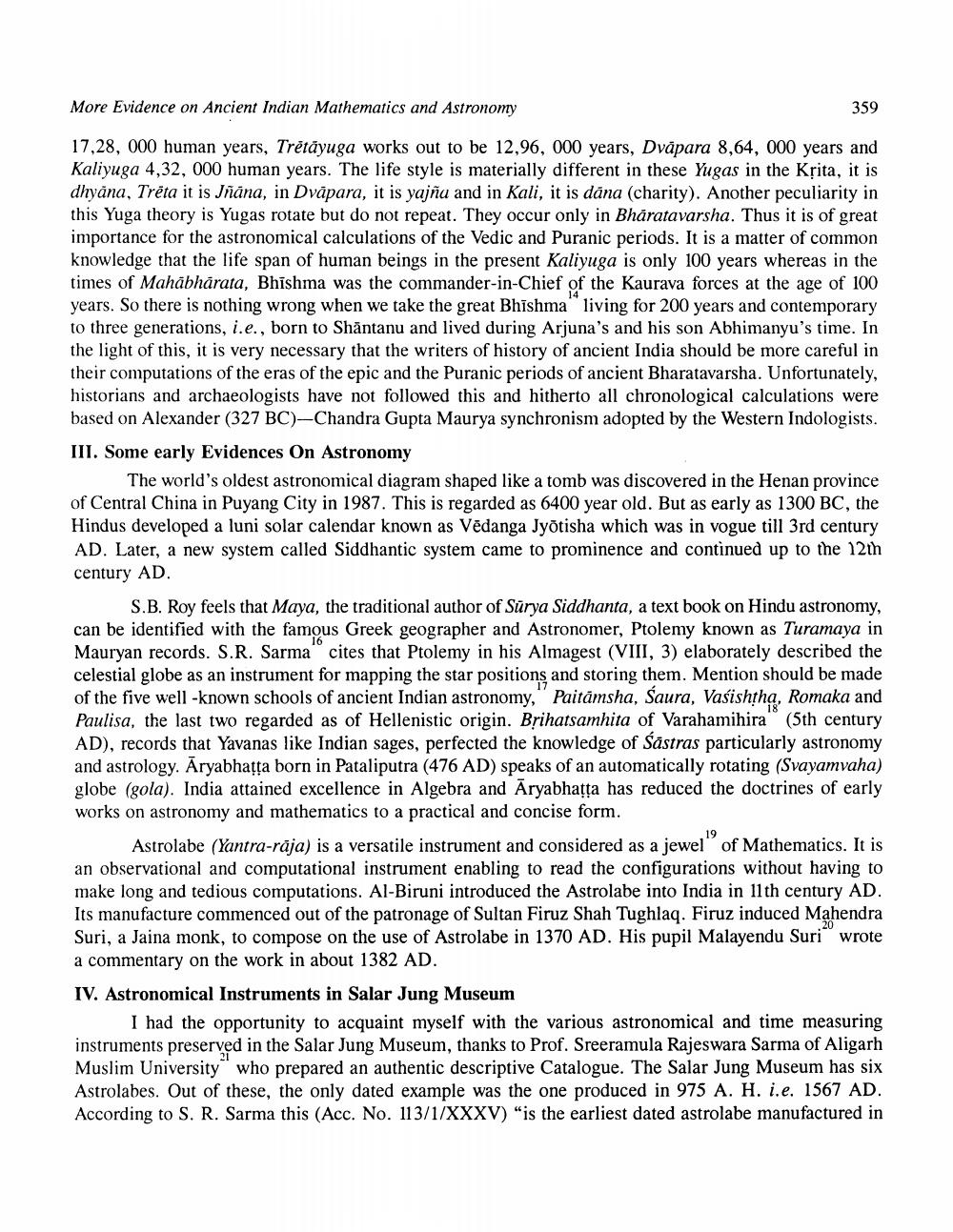________________
More Evidence on Ancient Indian Mathematics and Astronomy
359
17,28, 000 human years, Trētäyuga works out to be 12,96, 000 years, Dväpara 8,64, 000 years and Kaliyuga 4,32, 000 human years. The life style is materially different in these Yugas in the Kțita, it is dhyāna, Trēta it is Jñāna, in Dvāpara, it is yajña and in Kali, it is dāna (charity). Another peculiarity in this Yuga theory is Yugas rotate but do not repeat. They occur only in Bhäratavarsha. Thus it is of great importance for the astronomical calculations of the Vedic and Puranic periods. It is a matter of common knowledge that the life span of human beings in the present Kaliyuga is only 100 years whereas in the times of Mahābhārata, Bhishma was the commander-in-Chief of the Kaurava forces at the age of 100 years. So there is nothing wrong when we take the great Bhīshma living for 200 years and contemporary to three generations, i.e., born to Shantanu and lived during Arjuna's and his son Abhimanyu's time. In the light of this, it is very necessary that the writers of history of ancient India should be more careful in their computations of the eras of the epic and the Puranic periods of ancient Bharatavarsha. Unfortunately, historians and archaeologists have not followed this and hitherto all chronological calculations were based on Alexander (327 BC)-Chandra Gupta Maurya synchronism adopted by the Western Indologists. III. Some early Evidences On Astronomy
The world's oldest astronomical diagram shaped like a tomb was discovered in the Henan province of Central China in Puyang City in 1987. This is regarded as 6400 year old. But as early as 1300 BC, the Hindus developed a luni solar calendar known as Vēdanga Jyotisha which was in vogue till 3rd century AD. Later, a new system called Siddhantic system came to prominence and continued up to the 12th century AD.
S.B. Roy feels that Maya, the traditional author of Surya Siddhanta, a text book on Hindu astronomy, can be identified with the famous Greek geographer and Astronomer, Ptolemy known as Turamaya in Mauryan records. S.R. Sarma cites that Ptolemy in his Almagest (VIII, 3) elaborately described the celestial globe as an instrument for mapping the star positions and storing them. Mention should be made of the five well-known schools of ancient Indian astronomy, Paitāmsha, Saura, Vasishtha, Romaka and Paulisa, the last two regarded as of Hellenistic origin. Brihatsamhita of Varahamihira (5th century AD), records that Yavanas like Indian sages, perfected the knowledge of Sastras particularly astronomy and astrology. Aryabhatta born in Pataliputra (476 AD) speaks of an automatically rotating (Svayamvaha) globe (gola). India attained excellence in Algebra and Aryabhatta has reduced the doctrines of early works on astronomy and mathematics to a practical and concise form.
Astrolabe (Yantra-rāja) is a versatile instrument and considered as a jewel" of Mathematics. It is an observational and computational instrument enabling to read the configurations without having to make long and tedious computations. Al-Biruni introduced the Astrolabe into India in 11th century AD. Its manufacture commenced out of the patronage of Sultan Firuz Shah Tughlaq. Firuz induced Mahendra Suri, a Jaina monk, to compose on the use of Astrolabe in 1370 AD. His pupil Malayendu Suri wrote a commentary on the work in about 1382 AD. IV. Astronomical Instruments in Salar Jung Museum
I had the opportunity to acquaint myself with the various astronomical and time measuring instruments preserved in the Salar Jung Museum, thanks to Prof. Sreeramula Rajeswara Sarma of Aligarh Muslim University who prepared an authentic descriptive Catalogue. The Salar Jung Museum has six Astrolabes. Out of these, the only dated example was the one produced in 975 A. H. i.e. 1567 AD. According to S. R. Sarma this (Acc. No. 113/1/XXXV) "is the earliest dated astrolabe manufactured in




